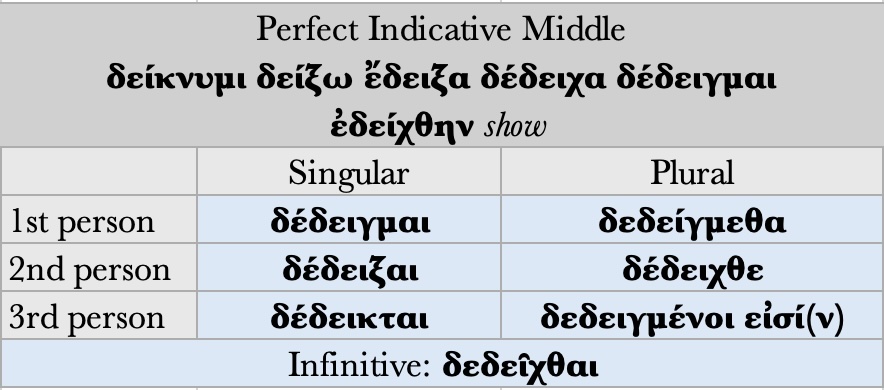43.1 As we learned in our last lesson, the PERFECT MIDDLE is formed by adding the PRIMARY MIDDLE ENDINGS directly to the PERFECT STEM. If the PERFECT STEM ends in a vowel (e.g. λέλυ-), the inflection pattern is straightforward. If the PERFECT STEM ends in a CONSONANT, however, a number of sound changes arise. Observe the following inflection of the PERFECT MIDDLE of δείκνυμι.
43.3 As you can see, when the final consonant of a PERFECT STEM (here –κ) encounters the initial sound of the middle personal endings, a number of sound changes occur. Though at first blush these sound changes may appear random, they are in fact regular and predictable (S 82-87, 103, G 42-47). In some cases, however, no sound change could ever make the verb comfortable to pronounce in Greek. In such situations, Greek replaces the – to them – unpronounceable verb form with a PERIPHRASTIC form, here δεδειγμένοι εἰσί.
In most languages, certain verb tenses are expressed not by one inflected form, but by two or more words that together express a single verbal action. Such combinations of words are called PERIPHRASTIC (< Greek περίφρασις talking around or circumlocution).
For example, in the English present tense, we can say He goes and He does go.
- He goes: not periphrastic, since the action is expressed in one verb form.
- He does go: periphrastic, since both words together form one verbal action.
In English, some verb tenses are always periphrastic. In the future tense, for example, we say:
- He will go.
As we can see in the above inflection of δείκνυμι, Greeks did not even try to say the 3rd person plural form (which would require somehow pronouncing *δέ-δεικ-νται). For this person and number, Greek instead uses a PERIPHRASTIC verb form (S 599). We discuss how to create and inflect these forms later in the lesson.


